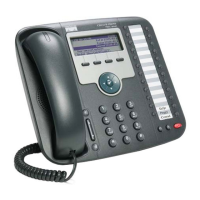8-6
Cisco Unified IP Phone 7931G Administration Guide for Cisco Unified Communications Manager 8.0 (SCCP and SIP)
OL-20798-01
Chapter 8 Monitoring the Cisco Unified IP Phone Remotely
Network Configuration
TFTP Server 1 Primary TFTP server used by the phone.
Default Router 1–5 Default router used by the phone (Default Router 1) and optional backup
routers (Default routers 2–5.
DNS Server 1–5 Primary DNS server (DNS Server 1) and optional backup DNS servers
(DNS servers 2–5) used by the phone.
Operational VLAN ID Auxiliary VLAN configured on a Cisco Catalyst switch in which the phone
is a member.
Admin. VLAN ID Auxiliary VLAN in which the phone is a member.
Unified CM 1–5 Host names or IP addresses, in prioritized order, of the
Cisco Unified Communications Manager servers with which the phone can
register. An item can also show the IP address of an SRST router that is
capable of providing limited Cisco Unified Communications Manager
functionality, if such a router is available.
For an available server, an item will show the Cisco Unified Communications
Manager server IP address and one of the following states:
• Active—Cisco Unified Communications Manager server from which the
phone is currently receiving call-processing services.
• Standby—Cisco Unified Communications Manager server to which the
phone switches if the current server becomes unavailable.
• Blank—No current connection to this Cisco Unified Communications
Manager server.
An option may also include the Survivable Remote Site Telephony (SRST)
designation, which indicates an SRST router capable of providing
Cisco Unified Communications Manager functionality with a limited feature
set. This router assumes control of call processing if all other Cisco Unified
Communications Manager servers become unreachable. The SRST
Cisco Unified Communications Manager always appears last in the list of
servers, even if it is active. You configure the SRST router address in the
Device Pool section in Cisco Unified Communications Manager.
Information URL URL of the help text that appears on the phone.
Directories URL URL of the server from which the phone obtains directory information.
Messages URL URL of the server from which the phone obtains message services.
Services URL URL of the server from which the phone obtains Cisco Unified IP Phone
services.
DHCP Enabled Indicates whether DHCP is being used by the phone.
DHCP Address
Released
Indicates the setting of the DHCP Address Released option on the phone’s
Network Configuration menu.
Alternate TFTP Indicates whether the phone is using an alternative TFTP server.
Forwarding Delay Indicates whether the internal switch begins forwarding packets between the
PC port and switched port on the phone when the phone becomes active.
Idle URL URL that the phone displays when the phone has not been used for the time
specified by Idle URL Time, and no menu is open.
Table 8-2 Network Configuration Area Items (continued)
Item Description

